完整版非谓语动词知识点总结
完整版)非谓语动词归纳总结

完整版)非谓语动词归纳总结非谓语动词归纳总结非谓语动词分为不定式、动名词和分词三种形式。
不定式包括基本形式和完成式,表示将来或发生在谓语动词之前的动作。
动名词和分词则分别表示主动和被动,动名词可用作名词,分词则可用作形容词或副词。
在句子中,非谓语动词常用于表目的、条件和原因等情况下。
例如,“To do”可表示为了某个目的,常带宾语;“Doing/Having done”则表示当某种情况发生时,常带宾语;而“XXX”则表示某种情况已经发生,不带宾语。
需要注意的是,有些情况下使用动词原形,如祈使句中,“Do”后面常用动词原形;而动名词则可作为主语出现,“Doing/Being done”后面可接谓语动词。
例如,仔细看,你就能发现这两张图片的不同之处。
1.Anyone who was seen carrying bags。
boxes。
or cases was XXX(作定语)2.Steam being produced XXX(作主语补足语)3.We decided to stay at home upon seeing the roads covered with snow and ice。
(作宾语补足语)4.The building that will be completed next month will be used as a XXX(作定语)5.The problem being discussed now is not the one that was XXX(作定语)6.XXX(作宾语补足语)7.XXX the air quality in Beijing。
(作目的状语)8.Don't keep the water running when you XXX(作宾语补足语)固定搭配:1.跟不定式作宾语的动词:Aim。
appear。
agree。
arrange。
decide。
choose。
非谓语动词知识点总结

非谓语动词知识点总结非谓语动词是英语语法中的一个重要知识点,它可以用来修饰主语或宾语,增强句子的表达力和信息量。
在本文中,我将详细介绍非谓语动词的用法和一些常见的形式。
希望通过本文的阅读,读者能够更好地理解和运用非谓语动词,提高自己的英语写作水平。
一、非谓语动词的定义和分类非谓语动词是指在句子中充当动词的成分,但不具备谓语的功能。
它不受主语的人称和数的限制,也不受时态的影响。
根据其形式和功能的不同,非谓语动词可以分为动名词、不定式和分词三种形式。
1. 动名词(Gerund)动名词是动词加上-ing形式构成的名词,常用作主语、宾语、表语、宾补等。
例如:- Smoking is harmful to health.(吸烟对健康有害)- I enjoy swimming in the sea.(我喜欢在海里游泳)- His hobby is playing basketball.(他的爱好是打篮球)2. 不定式(Infinitive)不定式是动词的原形加上to构成的形式,常用作动词、形容词或名词的补语。
例如:- He wants to buy a new car.(他想买一辆新车)- I have a lot of work to do.(我有很多工作要做)- The book is too heavy to carry.(这本书太重,无法携带)3. 分词(Participle)分词是动词的-ing形式(现在分词)或-ed、-en等形式(过去分词)构成的形容词,常用作定语、状语或补语。
例如:- The running water is very clear.(流动的水非常清澈)- The broken vase has been repaired.(打破的花瓶已经修好了)- We were surprised by the exciting news.(令人兴奋的消息让我们感到惊讶)二、非谓语动词的用法非谓语动词在句子中具有独立的语法功能,可以用来修饰名词、代词、动词、形容词和副词等,以及构成复合句的各种从句。
非谓语动词知识点总结

非谓语动词知识点总结非谓语动词知识点总结非谓语动词,又叫非限定动词,非谓语动词是指在句子中不是谓语的动词,接下来是小编为您整理的非谓语动词知识点总结,希望对您有所帮助。
I.概述1.基本形式的变化:不定式:时态主动态被动态一般式to doto be done进行式to be doing完成式to have builtto have been builtJohn said that he had run in order to catch the bus. (一般式的主动态)He hated to be misunderstood by others. (一般式的被动态) He pretended to be listening attentively. (进行式)He intended to have told you that. (完成式主动态)This work of art seemed to have been created several centuries ago. (完成式的被动态)v-ing形式时态主动态被动态一般式doingbeing done完成式having donehaving been done注意:不及物动词没有被动式动名词I am sure of his coming in time. (一般式主动态) (= I am sure that he will come in time)He is proud of being selected as monitor. (一般式被动态) (= He is proud that he is selected as monitor.)I’m confident of his having passed the exam. (完成式主动态) (= I am confident that he have passed the exam.)He complained of having been cheated by others. (完成式被动态)现在分词He sat in a chair,reading a novel. (一般式主动态)Being exhausted by work, he fell asleep quickly. (一般式被动态)Having finished his homework, he went playing. (完成式主动态)All this having been settled, he went home. (完成式被动态)2.所做成分项目/成分主语表语宾语宾补定语状语动词的ing形式现在分词△ △△△动名词△△△ △不定式△△△△△△过去分词△ △△△注:现在分词、不定式、过去分词都可以作独立成分。
(完整版)非谓语动词考点总结归纳

Tom is sure of passing the exam. ( Tom 对自己通过考试很有把握 .)
考点三:非谓语动词作表语 不定式、动名词、分词做表语:
1. 不定式做表语常表示谓语动词所表示动作之后发生的动作。不定式一般紧跟在系动词如
: be, seem, remain,
appear 等后面 , 用来说明主语的内容。这类结构中的主语一般为名词,如:
We met many guests ,most of them Americans.( 补充说明 )
非谓语动词考点总结归纳
非谓语动词包括 不定式,动名词和分词 。它们是高中所学的基础语法,也是高考必考内容。既是高考的难点又是 高考的热点。真正领悟非谓语动词的用法要具备以下基础知识:
①具有句子结构的知识,会分析句子成分。 ②具有简单句最基本的五种句型的知识,要分得清双宾语和复合宾语。 ③具有扎实而丰富的动词知识,要分得清及物动词和不及物动词。 ④具备各种复合句的知o melt.
2) 当 begin 和 start 用于进行时时 .
eg: He is beginning to study English.
3) 当 begin 和 start 后面跟着一些表示心理状态的词时 . eg: I began to believe his story.
2.分词 解题诀窍:找逻辑主语,辨逻辑关系,析动作先后
语法作用:
1)表示时间,相当于表示时间,相当于状语从句
when, while 。常用于连词 When, before, while, after,
since 等后面。也可以省略连词
eg. When allowed, we are supposed to come into the room.
非谓语动词总结知识点

非谓语动词总结知识点一、动词不定式(Infinitive)动词不定式由“to + 动词原形”构成。
动词不定式在句子中可以作多种成分,具有名词的性质。
下面是动词不定式的主要用法:1. 作主语:To travel around the world is my dream.2. 作宾语:I want to study English.3. 作定语:The best way to learn English is to practice speaking.4. 作表语:My goal is to improve my English.5. 作状语:He goes to the library to study every day.当动词不定式作为宾语补足语时,它可以由动词原形构成(Bare Infinitive)。
例如:I saw him draw a picture yesterday. (我昨天看到他画了一幅画。
)二、动名词(Gerund)动名词是由动词的现在分词形式加上动词-ing构成的。
动名词在句子中可以作多种成分,具有名词的性质。
下面是动名词的主要用法:1. 作主语:Reading is my hobby.2. 作宾语:I enjoy swimming in the ocean.3. 作定语:I like watching movies.4. 作表语:His favorite activity is playing basketball.5. 作状语:He left without saying goodbye.动名词与不定式的区别在于,动名词具有名词的性质,而动词不定式具有动词的性质。
例如:I like swimming. (我喜欢游泳。
)I like to swim. (我喜欢游泳。
)动名词与动词不定式作宾语时,有时可以根据动词选择使用不定式还是动名词。
例如:I stopped smoking. (我戒烟了。
(完整版)高考英语非谓语动词知识点
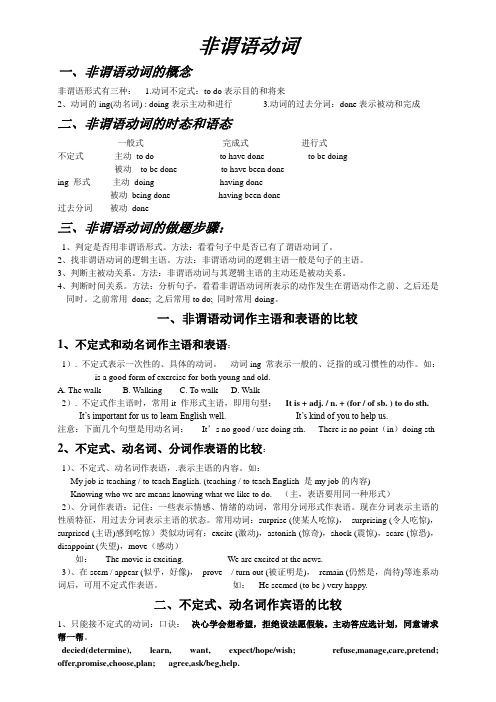
非谓语动词一、非谓语动词的概念非谓语形式有三种: 1.动词不定式:to do表示目的和将来2、动词的ing(动名词) : doing表示主动和进行 3.动词的过去分词:done表示被动和完成二、非谓语动词的时态和语态一般式完成式进行式不定式主动to do to have done to be doing被动to be done to have been doneing 形式主动doing having done被动being done having been done过去分词被动done三、非谓语动词的做题步骤:1、判定是否用非谓语形式。
方法:看看句子中是否已有了谓语动词了。
2、找非谓语动词的逻辑主语。
方法:非谓语动词的逻辑主语一般是句子的主语。
3、判断主被动关系。
方法:非谓语动词与其逻辑主语的主动还是被动关系。
4、判断时间关系。
方法:分析句子,看看非谓语动词所表示的动作发生在谓语动作之前、之后还是同时。
之前常用done; 之后常用to do; 同时常用doing。
一、非谓语动词作主语和表语的比较1、不定式和动名词作主语和表语:1). 不定式表示一次性的、具体的动词。
动词ing 常表示一般的、泛指的或习惯性的动作。
如:________ is a good form of exercise for both young and old.A. The walkB. WalkingC. To walkD. Walk2). 不定式作主语时,常用it 作形式主语,即用句型:It is + adj. / n. + (for / of sb. ) to do sth.It’s important for us to learn English well. It’s kind of you to help us.注意:下面几个句型是用动名词:It’s no good / use doing sth. There is no point(in)doing sth2、不定式、动名词、分词作表语的比较:1)、不定式、动名词作表语,.表示主语的内容。
非谓语动词最完整版

非谓语动词一、非谓语动词的概念动词的基本用法是作谓语。
当句中已经有了谓语动词了,要选或要填的动词就只能用非谓语形式了。
二、非谓语形式的三种形式及基本用法:1、动词不定式:to do 表示目的和将来2、动词的ing : doing 表示主动和进行3、动词的过去分词:done 表示被动和完成非谓语动词(一)——动词不定式一、不定式(to do)不定式由“to+动词原形”构成,其否定形式是“not to+动词原形”。
不定式可以带宾语或状语构成不定式短语,没有人称和数的变化,但有时态和语态的变化。
不定式可作主语、宾语、状语、表语和定语,但不能单独作谓语。
不定式运用口诀:本领最多不定式,主,表,宾,补,定和状,样样成分都能干,只有谓语它不敢,大家千万要当心,有时它把句型改,做主宾时用“it”,自己在后把身藏,七个感官三使役,宾补要把to甩开,疑问词后接上它,宾语从句可充当,逻辑主语不定式,不定式前for sb,to前not 是否定,各种用法区别开。
1. I am sorry to ________ you so much trouble. (2008 江苏)A. have givenB. have been givenC. giveD. giving答案:A简析:be sorry to have done sth 意为“已经干了某事而遗憾”,to have done是不定式的完成形式,表示先于谓语动词的动作。
B,被动形式,不合题意。
变式训练:2.The promising young man is said to ______ two novels.A. have writtenB. have been writtenC. writeD. writing (A)2.不定式的句法功能1)作主语:(谓语动词一般用单数)To finish the work in ten minutes is very hard.在十分钟内完成这项工作很难。
英语非谓语动词知识点

英语非谓语动词知识点1) 总的概述:不定式作主语——具体的,一次性的To understandothers is hard.动名词作主语——一般的,经常性的Washing clothes is her daily job.分词不能作主语——分词有形/副的作用,但主语只能是带有名词意义的词2) 具体用法:动名词在句型里作主语的运用:i. It’s no good/ useless/ a waste of time/ a good pleasure + doi ng sth. (it’s+形容词/形容词性短语+doing)It’s a waste of time dating you.ii. It’s + adj. + 动名词It’s delighted playing.iii. There was/ is + no + doingThere is no standing still in this life.1) 不定式的逻辑主语不定式不能作自己的主语,但在意思上仍然有履行该动作的逻辑主语,其逻辑主语前总有“for/ of”的标志。
It’s foolish of you to stay away from your family.The hardest thing is for him to give up.She was sent there to be trained as a teacher.2) 动名词的逻辑主语当动名词的逻辑主语与句子主语不一致时,应在动名词前加上物主代词/名次属格来作其逻辑主语。
Your being curious almost hurt yourself.3) There be句型Of there beingHe spoke of there being a magnificent ranch.For / about there to beIt’s easy for there to be a gap between parents and children.1) 能接动名词作宾语的动词为防止危险-禁止犯罪-假设犯,应坦白/成认escape/ avoid-forbid- confess/ acknowledge/ admit男方推迟约会-女方介意,忍耐,原谅-再犯,放弃put off/delay-mind/tolerate/endure/excuse/pardon/forgive-give up提倡的建议-被民众喜欢/感激advocate/ suggest-enjoy/ appreciate2) 介词后只能接动名词Feel like doing sth.Be/ get used to doing sth.其他的都是介词+(in)doing sth.1) 能接不定式为宾语的动词往往差生-自愿参军-准备提出申请-等待同意tend-volunteer-prepare/ offer-agree渴望梦想-下定决心-做好计划/打算-尽力/设法去实现long-determine-plan/ aim-endeavor/manage未能拒绝要求-假装(做外表工作)fail/ refuse/ ask/ claim/ demand-pretend2) 连词except/ but与不定式except/but只能与不定式,不能与动名词连用We have no choicebut to wait.但假设前有do,那么except/but后也只能加do(前后一致)Iwould do anything for you except to be a missioner.1) 接动名词/不定式,意思都不变的动词喜欢一个人-憎恨麻烦-宁可不追求like/love-hate-prefer计划/试图创业-开始遇难-无法继续-停止告终intend/attempt-begin/start-continue-cease假设like/love/hate/prefer前有should/would,那么只能接不定式(本来would/should只能接动原,为让步,加带“to”的动原)Iwould like to have a drink.2) 接动名词/不定式,会改变本义的动词进程改变(to do未完成;doing正在做/做过了)记得-忘记-后悔-停止-继续remember/forget-regret-stop-go on意义改变当别人需要你时-尝试忍住不耐-设法去帮助他们need-try/ stand-mean/ helpTo do人设法做不忍心想要做帮助Doing物(主作被)试着做忍受意味着禁不止3) 在这些动词这,动名词作宾语,不定式作宾语补足语该俱乐部只允许有推荐信的人申请-假设无,那么禁止入内-建议呱permit/ allow-remend-forbid-adviseIdon’t allow you to go.My dad doesn’t allow smokingin our family.1) 分词作补语-现在分词~动作正在进行/状态;过去分词~被动Iheard someone knocking at the door.(就省去that和was了)She kept us waiting for 2 hours!Iheard the song sung.(用歌被唱表示人在唱歌)不定式作补语-还未完成Please remind me to take my medicine.我想要劝他去帮助1) Want/wish-后加(to be) doneIwant it finished today.2) 表示劝请/要求Teac h/ ask/ remind…表示劝请/要求的动词后都可以接sb. to do sth.Ididn’t ask you to do it for me.Hope/ agree/ suggest/demand/decide后不可加sb. to do sth. Hope/ agree/ suggest + thatDemand/ decide + to do3) 使役动词have/make/let后加不带to的不定式,但在动词为主语的被动语态时可接to doHe makes his son study.He was made to study.4) Help后加不加to都无所谓You got to help me to fix it.Idon’twant to help you fix it.现在分词-性质:It is exciting.过去分词-状态:The store is closed.Washing clothes is my daily task.在主系表句型中,假设主语局部有实义动词do的某种形式,那么作主语补足语的不定式既可以带to也可不带toThe last thing Iwant to do is (to) arguewith you.分词:Not obtaining a ticket for the match动名词:Not being tall不定式:Not to be tallThe racing horse = thehorse is racingA fallen leaf = a leaf that alreadyfallen.The buildingpleted before = the buildingwas pleted before. The washing machine= themachineis for washing.The meeting to be continued is on our top agenda.1) 分词-时间/原因/让步/条件/方式/伴随伴随:Iwas sad, wandering alone the river.原因:Being a good father, Ineed to work harder.条件:Given more time, Icould make it.2) 不定式-目的/结果/原因目的:To satisfymyself, Idecide to have a good meal.结果:Iwas too scareto ask him. / The three men tried many times to sneak across the border into the neighboring country, only to be captured by the police each time.1) 分词的独立结构(修饰分句)假设分词修饰的主语与主句的主语不一致,那么分词要有自己的逻辑主语——逻辑主语+分词(可表时间/原因/伴随/条件/目的)The guest having departed, I laid on my bed and fall asleep. Time permitting, we should stay here a littlebit longer.Her son lost, she got crazy.2) 某些不加逻辑主语的分词短语的独立结构(修饰全句)总的/严格来说-假设这是判断题-该如何判断是否正确呢Generally/strictly speaking-provided/providing/suppose/ given-judgingfrom谈到未来的职业选择-考虑到我的兴趣-是在关于,包括语言方面的-既然是这样,所以我决定考研talking of-considering/ given-regarding/concerning-including-seeing that3) 不定式的独立结构To tell the truth; to be plain with you; to be brief; to be honest; to sum up; to cut a long story short; to say the least; to be sure; to begin with; not to mention; strangeto say; needless to say; to conclude(其实2和3这两个知识点都是一样的,分词和不定式的独立结构都是在修饰全句,而不是单单一个主语,因此我们可以把这些分词和不定式的独立结构看作一个固定搭配。
(完整版)非谓语的用法总结
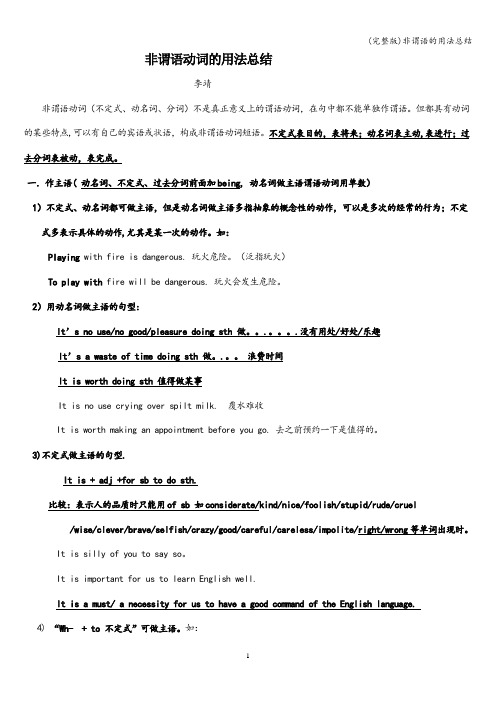
非谓语动词的用法总结李靖非谓语动词(不定式、动名词、分词)不是真正意义上的谓语动词,在句中都不能单独作谓语。
但都具有动词的某些特点,可以有自己的宾语或状语,构成非谓语动词短语。
不定式表目的,表将来;动名词表主动,表进行;过去分词表被动,表完成。
一.作主语( 动名词、不定式、过去分词前面加being, 动名词做主语谓语动词用单数)1)不定式、动名词都可做主语,但是动名词做主语多指抽象的概念性的动作,可以是多次的经常的行为;不定式多表示具体的动作,尤其是某一次的动作。
如:Playing with fire is dangerous. 玩火危险。
(泛指玩火)To play with fire will be dangerous. 玩火会发生危险。
2)用动名词做主语的句型:It’s no use/no good/pleasure doing sth 做。
.。
.没有用处/好处/乐趣It’s a waste of time doing sth 做。
.。
浪费时间It is worth doing sth 值得做某事It is no use crying over spilt milk. 覆水难收It is worth making an appointment before you go. 去之前预约一下是值得的。
3)不定式做主语的句型.It is + adj +for sb to do sth.比较:表示人的品质时只能用of sb 如considerate/kind/nice/foolish/stupid/rude/cruel /wise/clever/brave/selfish/crazy/good/careful/careless/impolite/right/wrong等单词出现时。
It is silly of you to say so。
It is important for us to learn English well.It is a must/ a necessity for us to have a good command of the English language.4) “Wh- + to 不定式”可做主语。
(完整版)非谓语动词归纳总结
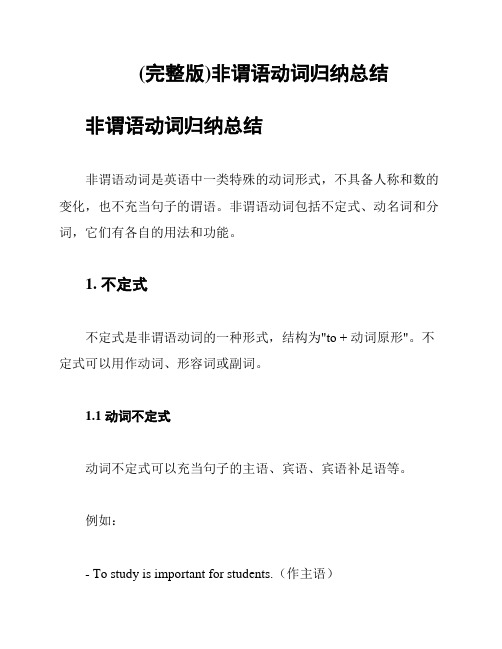
(完整版)非谓语动词归纳总结非谓语动词归纳总结非谓语动词是英语中一类特殊的动词形式,不具备人称和数的变化,也不充当句子的谓语。
非谓语动词包括不定式、动名词和分词,它们有各自的用法和功能。
1. 不定式不定式是非谓语动词的一种形式,结构为"to + 动词原形"。
不定式可以用作动词、形容词或副词。
1.1 动词不定式动词不定式可以充当句子的主语、宾语、宾语补足语等。
例如:- To study is important for students.(作主语)- I want to learn English.(作宾语)- She asked me to help her.(作宾语补足语)1.2 形容词不定式形容词不定式用于修饰名词或代词。
例如:- I have a book to read.(修饰名词)- He is the man to trust.(修饰代词)1.3 副词不定式副词不定式用于修饰动词、形容词或副词。
例如:- She worked hard to pass the exam.(修饰动词)- He is happy to see you.(修饰形容词)- She walked quickly to catch the bus.(修饰副词)2. 动名词动名词是非谓语动词的一种形式,结构为动词的现在分词形式。
动名词可以充当句子的主语、宾语、宾语补足语等。
例如:- Swimming is good exercise.(作主语)- I enjoy playing basketball.(作宾语)- She kept on talking.(作宾语补足语)3. 分词分词是非谓语动词的一种形式,根据时态和完成程度的不同,分词分为现在分词和过去分词。
3.1 现在分词现在分词用于表示主动或进行的动作。
例如:- The running boy is my brother.(作定语)- She stood there, crying.(作状语)3.2 过去分词过去分词用于表示被动或完成的动作。
非谓语动词知识点总结

非谓语动词知识点总结非谓语动词是指在句子中不作谓语的动词形式,包括不定式、动名词和分词。
它们具有多种用法和功能,下面将对非谓语动词的知识点进行总结。
一、不定式1. 不定式的形式:以to+动词原形构成,如to eat、to go等。
2. 不定式作主语:To learn English is important.3. 不定式作宾语:I want to eat an apple.4. 不定式作表语:My dream is to become a doctor.5. 不定式作定语:I have a book to read.6. 不定式作状语:She woke up early to catch the train.二、动名词1. 动名词的形式:动词+ing形式,如eating、going等。
2. 动名词作主语:Swimming is good for health.3. 动名词作宾语:I enjoy playing basketball.4. 动名词作表语:His hobby is fishing.5. 动名词作定语:I have a writing task to finish.6. 动名词作状语:He left without saying goodbye.三、分词1. 分词的形式:分为现在分词和过去分词两种形式,如working、played等。
2. 现在分词作主语:Reading helps improve vocabulary.3. 现在分词作宾语:She heard someone calling her name.4. 现在分词作表语:He is a hardworking student.5. 现在分词作定语:I saw a running dog in the park.6. 现在分词作状语:He left the room, closing the door behind him.7. 过去分词作宾语补足语:I found the door closed.四、非谓语动词的逻辑主语1. 不定式的逻辑主语:It is important to learn English.2. 动名词的逻辑主语:Swimming helps improve health.3. 分词的逻辑主语:Reading books is beneficial for children.五、非谓语动词的否定形式1. 不定式的否定形式:not+不定式,如not to go、not to eat等。
非谓语动词知识点总结

非谓语动词知识点总结非谓语动词是指在句子中充当动词的形式,但不具备谓语的功能。
它可以作为动词、形容词或副词的补充,用来修饰主语或宾语。
非谓语动词包括动词不定式、动名词和分词。
在英语中,非谓语动词的使用非常灵活,可以丰富句子结构,增强表达的准确性和流畅度。
一、动词不定式动词不定式是非谓语动词的一种形式,由“to + 动词原形”构成。
动词不定式可以作为主语、宾语、表语、定语和状语等,具有多种用法。
1. 动词不定式作主语动词不定式作主语时,常常放在句首,后面跟动词原形。
例如:To travel around the world is my dream.旅行世界是我的梦想。
2. 动词不定式作宾语动词不定式作宾语时,常常放在动词后面。
例如:I want to learn how to play the guitar.我想学习弹吉他。
3. 动词不定式作表语动词不定式作表语时,常常放在系动词后面。
例如:Her dream is to become a doctor.她的梦想是成为一名医生。
4. 动词不定式作定语动词不定式作定语时,常常放在名词前面,修饰名词。
例如:The best way to learn English is to practice every day.学习英语的最好方法是每天练习。
5. 动词不定式作状语动词不定式作状语时,常常放在句子后面,修饰整个句子。
例如:He woke up early to catch the train.他早起赶火车。
二、动名词动名词是非谓语动词的一种形式,它是动词加上-ing构成的名词。
动名词可以作主语、宾语、表语、定语和状语等,具有多种用法。
1. 动名词作主语动名词作主语时,常常放在句首。
例如:Swimming is good for your health.游泳对健康有益。
2. 动名词作宾语动名词作宾语时,常常放在动词后面。
例如:I enjoy reading books in my free time.我喜欢在空闲时间读书。
(详细版)非谓语动词总结要点

(详细版)非谓语动词总结要点非谓语动词总结要点一、非谓语动词的基本概念非谓语动词是指在句子中充当动词的成分,但不具备时态和人称变化。
常见的非谓语动词包括动词不定式、动名词和分词。
二、动词不定式的特点和用法1. 动词不定式的特点:不定式一般由to + 动词原形构成。
2. 动词不定式的用法:- 作主语:To travel around the world is my dream.- 作宾语:She loves to sing and dance.- 作宾语补足语:They want me to join their team.- 作状语:I study hard to improve my English.- 与某些动词连用,如hope, expect, want, agree等:I hope to see you soon.三、动名词的特点和用法1. 动名词的特点:动名词一般由动词-ing形式构成。
2. 动名词的用法:- 作主语:Swimming is good for your health.- 作宾语:I enjoy reading books.- 作宾语补足语:She found pleasure in helping others.- 作定语:The running water sounds relaxing.四、分词的特点和用法1. 分词的特点:分词形式有现在分词(-ing形式)和过去分词(-ed或其他形式)。
2. 分词的用法:- 现在分词作状语:Seeing the accident, he hurried to call an ambulance.- 过去分词作定语:The broken window needs to be repaired.五、非谓语动词的时态和语态非谓语动词没有时态和人称变化,但可以与助动词连用,表示完成、进行、将来等不同的时态。
同时,非谓语动词也可以使用被动语态。
最全的非谓语动词知识点总结
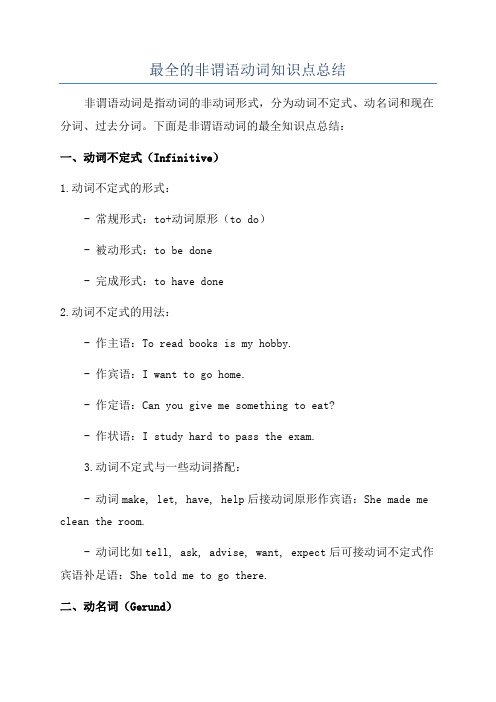
最全的非谓语动词知识点总结非谓语动词是指动词的非动词形式,分为动词不定式、动名词和现在分词、过去分词。
下面是非谓语动词的最全知识点总结:一、动词不定式(Infinitive)1.动词不定式的形式:- 常规形式:to+动词原形(to do)- 被动形式:to be done- 完成形式:to have done2.动词不定式的用法:- 作主语:To read books is my hobby.- 作宾语:I want to go home.- 作定语:Can you give me something to eat?- 作状语:I study hard to pass the exam.3.动词不定式与一些动词搭配:- 动词make, let, have, help后接动词原形作宾语:She made me clean the room.- 动词比如tell, ask, advise, want, expect后可接动词不定式作宾语补足语:She told me to go there.二、动名词(Gerund)1.动名词的形式:- 动词原形+ing(doing)2.动名词的用法:- 作主语:Swimming is good for health.- 作宾语:I enjoy reading books.- 作表语:His job is teaching English.- 作定语:The running water sounds relaxing.- 作状语:I walked home, singing songs.3.动名词与一些动词搭配:- 动词stop, finish, keep, mind后接动名词作宾语:He finished reading the book.- 动词enjoy, dislike, mind后接动名词作宾语:I enjoy swimming.三、现在分词(Present Participle)1.现在分词的形式:- 原形+ing(doing)2.现在分词的用法:- 作定语:The crying baby needs attention.- 作状语:He left the party, feeling disappointed.3.现在分词与一些动词搭配:- 动词keep, catch, find后接现在分词作宾补:I caught him stealing my money.- 动词see, hear, notice后接现在分词作宾补:I saw him walking in the park.四、过去分词(Past Participle)1.过去分词的形式:- 动词的过去分词形式(done)2.过去分词的用法:- 用于完成时态:I have finished my homework.- 用于被动语态:The book was written by him.3.过去分词与一些动词搭配:- 动词have, has, had, get, be等后接过去分词构成完成时态:He has eaten breakfast.- 动词make, let, have, get后接过去分词构成被动语态:She was made to clean the room.。
非谓语动词总结知识点

非谓语动词总结知识点非谓语动词是英语中非常重要的语法现象,它们包括不定式、动名词和分词。
非谓语动词在句子中不能独立作谓语,但可以充当其他成分,如主语、宾语、定语、补语或状语。
不定式(Infinitive)不定式通常表示动作的未完成性或一般性。
它由“to”加上动词原形构成,有时也可以不带“to”。
不定式可以表示目的、原因、结果或条件。
- 表示目的:He went to the library to read a book.- 表示原因:She is happy to see you.- 表示结果:To my surprise, he won the first prize.- 条件:If you study hard, you will pass the exam.动名词(Gerund)动名词是动词的-ing形式,它具有名词的特性,可以作主语、宾语或表语。
动名词通常表示正在进行的动作或习惯。
- 作主语:Swimming is good for health.- 作宾语:I enjoy reading.- 作表语:My hobby is collecting stamps.分词(Participle)分词有两种形式:现在分词和过去分词。
现在分词通常以-ing结尾,过去分词形式多样。
分词可以作定语、补语或状语。
- 现在分词作定语:The boy running in the park is my brother.- 过去分词作定语:The letter written by her was very touching. - 现在分词作补语:I found the book interesting.- 过去分词作补语:The room was cleaned by the maid.非谓语动词的时态和语态非谓语动词的时态和语态通过不同的形式表达。
现在分词表示进行或主动;过去分词表示完成或被动;不定式表示未完成或一般性。
非谓语用法总结-高考完整版
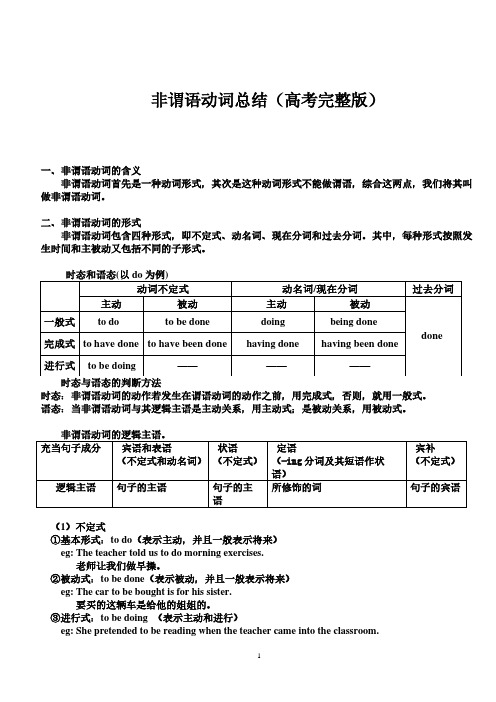
非谓语动词总结(高考完整版)一、非谓语动词的含义非谓语动词首先是一种动词形式,其次是这种动词形式不能做谓语,综合这两点,我们将其叫做非谓语动词。
老师进来时,她假装正在读书。
④完成时:to have done(表示主动和完成)eg: The thief is said to have escaped.据说小偷已经逃跑了。
⑤完成被动式:to have been done(表示被动和完成)eg:The thief is said to have been arrested.据说小偷已经被抓住了。
⑥完成进行式:to have been doing (表示主动和完成进行)eg: She is said to have been working in the factory over the last 20 years.据说在过去的20年里,她一直在这家工厂工作。
(2)动名词①基本形式:doing (表示主动)eg: Travelling in space by ordinary people will be common in the future.在未来,普通人在太空旅行将会是普遍的事情。
②被动式:being done(表示被动)eg: Freddy and his band could go nowhere without being followed by their fans.弗雷迪和他的乐队到哪里都被他们的粉丝跟着。
③完成式:having done(表示主动和完成)eg: I have no idea of his having done such a thing against you.我不知道他做过这样一件违背你的事情。
④完成被动式:having been done(表示被动和完成)eg: Many customers complain of having been given short weight at that shop.很多顾客抱怨在那家商店被缺斤少两过。
最全的非谓语动词知识点总结
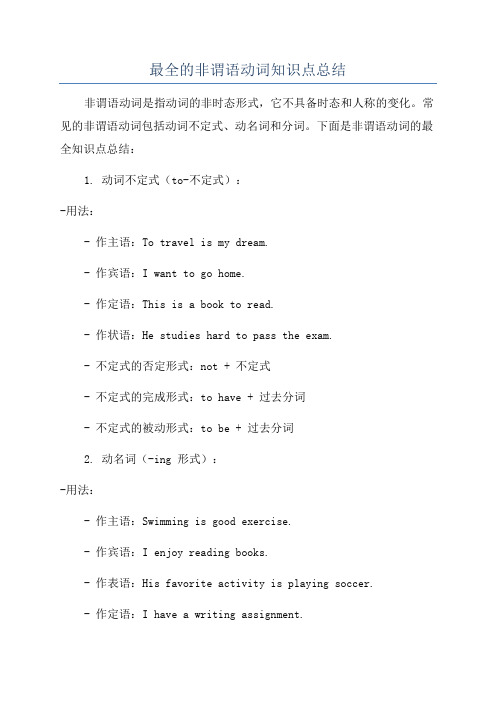
最全的非谓语动词知识点总结非谓语动词是指动词的非时态形式,它不具备时态和人称的变化。
常见的非谓语动词包括动词不定式、动名词和分词。
下面是非谓语动词的最全知识点总结:1. 动词不定式(to-不定式):-用法:- 作主语:To travel is my dream.- 作宾语:I want to go home.- 作定语:This is a book to read.- 作状语:He studies hard to pass the exam.- 不定式的否定形式:not + 不定式- 不定式的完成形式:to have + 过去分词- 不定式的被动形式:to be + 过去分词2. 动名词(-ing 形式):-用法:- 作主语:Swimming is good exercise.- 作宾语:I enjoy reading books.- 作表语:His favorite activity is playing soccer.- 作定语:I have a writing assignment.- 作状语:She left, crying.- 动名词的否定形式:not + 动名词-动名词可以表示一些动作、状态或者习惯性的行为3.分词:- 现在分词(-ing 形式):-用法:- 作定语:The running water is cold.- 作状语:He left, whistling a tune.-合并式现在分词:在主语和系动词之间发生合并,形成一个合并式的形容词。
- The girl is crying. (合并式:The girl is crying.)- 过去分词(一般以 -ed 或 -en 结尾):-用法:- 作定语:A broken window needs to be fixed.- 作状语:I was tired, so I went to bed.-分词作定语时,与被修饰词之间具有被动、完成、被完成等被动意义。
非谓语动词全总结

非谓语动词全总结一.非谓语动词的含义非谓语动词首先是一种动词形式,其次是这种动词形式不能做谓语,综合这两点,我们将其叫做非谓语动词。
二. 非谓语动词的形式非谓语动词包含四种形式,即不定式、动名词、现在分词和过去分词。
具体形式如下:1. 不定式:to do(表示主动,并且一般表示将来)例如:The teacher told us to do morning exercises .老师让我们做早操。
2. 动名词:doing (表示主动)例如:Travelling in space by ordinary people will be common in the future.在未来,普通人在太空旅行将会是普遍的事情。
3. 现在分词:doing (表示主动和进行)例如:He sat there,reading a newspaper.他坐在那里,读着一张报纸。
4. 过去分词:done及物动词的过去分词表示被动或完成;不及物动词的过去分词表示主动或完成。
polluted river 被污染的河流(及物动词pollute和river之间是被动关系,即“河流被污染”)fallen leaves 落叶(不及物动词fall和leaves之间是主动关系,即“叶子落下来”)注意:非谓语动词本身不能表示现在和过去。
非谓语动词表示进行和将来是相对于谓语动作来说的:和谓语动作同时发生表示进行;发生在谓语动作之后表示将来三. 非谓语动词的作用非谓语动词除去不能做谓语之外,其它所有成分都可以做。
具体如下。
1. 不定式:做主语、宾语、表语、定语、状语和补语。
To learn a foreign language is difficult .(作主语)学会一门外语是很难的。
It’s easy to see their aunt.(作真正主语,it做形式主语)很容易见到他们的姑姑。
Tom wanted to have a cup of beer.(作宾语)汤姆想要喝杯啤酒。
(完整版)非谓语动词归纳总结
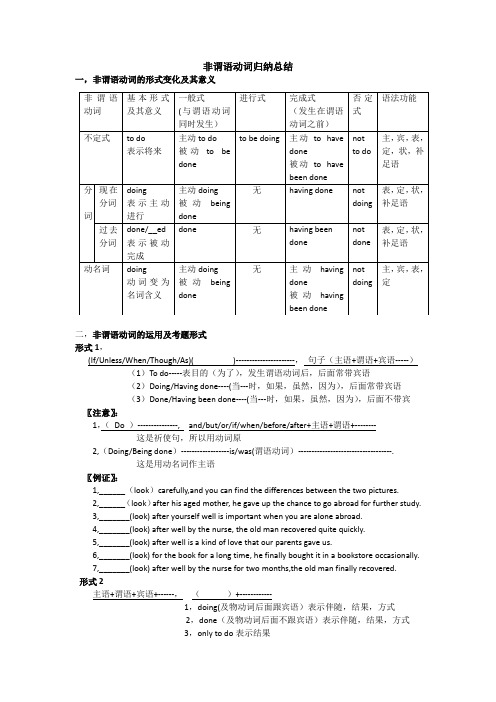
非谓语动词归纳总结一,非谓语动词的形式变化及其意义二,非谓语动词的运用及考题形式形式1,(If/Unless/When/Though/As)( )----------------------,句子(主语+谓语+宾语-----)(1)To do-----表目的(为了),发生谓语动词后,后面常带宾语(2)Doing/Having done----(当---时,如果,虽然,因为),后面常带宾语(3)Done/Having been done----(当---时,如果,虽然,因为),后面不带宾〖注意〗:1,(Do )---------------, and/but/or/if/when/before/after+主语+谓语+--------这是祈使句,所以用动词原2,(Doing/Being done)------------------is/was(谓语动词)-----------------------------------.这是用动名词作主语〖例证〗:1,______(look)carefully,and you can find the differences between the two pictures.2,______(look)after his aged mother, he gave up the chance to go abroad for further study.3,_______(look) after yourself well is important when you are alone abroad.4,_______(look) after well by the nurse, the old man recovered quite quickly.5,_______(look) after well is a kind of love that our parents gave us.6,_______(look) for the book for a long time, he finally bought it in a bookstore occasionally.7,_______(look) after well by the nurse for two months,the old man finally recovered.形式2主语+谓语+宾语+------,()+------------1,doing(及物动词后面跟宾语)表示伴随,结果,方式2,done(及物动词后面不跟宾语)表示伴随,结果,方式3,only to do表示结果〖例证〗1,A hearty laughter releases physical tension, ( )(leave) our muscle relaxed for half an hour. 2,The old grandma got off the bus, ()(support)by her granddaughter.3,We hurried to the railway station, only( )(find) the train had already left.4,He got up,washed his faces,had his breakfast, and( )(go) to work.形式3主语()+ 谓语+ 宾语()+-------------1,to do将要做的to be done将被做的(作定语或宾语补足语)2,doing正在做的being done正在被---的(作定语或宾语补足语)3,done被----了的(作定语或宾语补足语)〖例证〗1,Anyone________(see)________(carry)bags,boxes,cases was stopped by the police.(作定语)2,Steam can be seen__________(rise) when water is heated.(作主语补足语)3,Seeing the roads _____(cover) with snow and ice, we decided to stay at home.(作宾语补足语)4,The building _________(complete) next month will be used as a laboratory.(作定语)5,The problem______(discuss) now is not the one _____(discuss)at yesterday’s meeting (作定语)6,He spoke loudly enough to make himself __________(hear) clearly.(作宾语补足语)7,The government has taken effective measures________(improve) the air condition in Beijing.(作目的状语)8,Don’t keep the water ________(run) when you brush teeth.(作宾语补足语)三,固定搭配1,跟不定式作宾语的动词Aim,appear,agree,arrange,decide,choose,demand,desire,determine,expect,hope,fail,happen, hesitate,learn,mean,manage,offer,plan,prepare,pretend,promise,refuse,attempt,want2,跟动名词作宾语的动词Consider,suggest,advise,excuse,pardon,admit,delay,putoff,fancy,avoid,miss,keep,practice,deny,finish,enjoy,appreciate,can’t help,forbid,imagine,risk,mind,allow,permit,escape3,to后面跟动名词的短语Be/get used to,be related to,be addicted to,be opposed to,be devoted to,be adjusted to,be connected to,be compared to,lead to,object to,look forward to,stick to,pay attention to,contribute to,make contributions to,reply to,turn to,belong to,respond to。
- 1、下载文档前请自行甄别文档内容的完整性,平台不提供额外的编辑、内容补充、找答案等附加服务。
- 2、"仅部分预览"的文档,不可在线预览部分如存在完整性等问题,可反馈申请退款(可完整预览的文档不适用该条件!)。
- 3、如文档侵犯您的权益,请联系客服反馈,我们会尽快为您处理(人工客服工作时间:9:00-18:30)。
非谓语动词就是不能作句子谓语而具有其他语法功能的动词。
表语:主语/ 不定式和ing分词均能作主语,二者有何区别?表示某一具体的动作时,多用不定式;表示比较抽象的一般行为倾向的,多 1.用动名词。
作形式主2.动名词作主语时通常位于句首;不定式作主语时常置于句末,用it语放在句首。
1) Smoking is prohibited(禁止)here.2) It is not very good for you to smoke so much.Seeing is believing.To see is to believe.若主语和表语都是非谓语动词, 应保持形式上的一致。
宾语:1. 有些动词后只跟不定式作宾语,如:帮……manage, promise, pretend, plan, offer, agree, ask, dare, choose, fail, help(want(想要) , refuse等。
助),决心学会想希望,拒绝设法愿假装。
主动答应选计划,同意请求帮一帮。
2. 有些动词后只跟动名词作宾语,如:practise, appreciate, dislike, excuse, forgive, keep, resist, risk, deny, advise,fancy, ……complete, forbid, permit, allow, stand, refer to, give up, lead to, take to, set about, getdown to, object to, succeed in, have difficulty in... 考虑建议盼原谅,承认推迟没得想。
避免错过继续练,否认完成就欣赏。
禁止想象才冒险,不禁介意准逃亡。
分后既可以跟不定式又可以跟ing3.有些动词如begin, start; love, like, hate, prefer 不定式表示具分词一般表示经常性的行为;词作宾语,意义上无多大区别(但ing。
体的行为) 4.有些动词后既可以跟不定式,又可以跟动名词作宾语,但意义上有明显差别。
go on(stop/remember/regret)to do/doingmean to do(打算)/ doing(意味)can't help to do / doing try to do/ doing be used to do / doing (used to do) ( get used to doing),主动表被动,deserve作“应受,应得”5.动词need, require, want作“需要”定语:分词和过去分词都可以作定语,主要区别在于它们的时态意义不定式、ing 和语态意义。
分词作定语与动词不定式作定语的区别是:现在分词表示主动、进行之意;而不定式表示在谓语动词表示的动作之后即将发生的过去分词表示被动与完成;动作。
表主动关no, all, any 等限定词的中心词,不定式用来修饰序数词、最高级或系。
E.g.: The car to be bought is for his sister. / He was the best man to do the job. The houses being built are for the teachers.Developing countries/ developed countries补语:ask, advise, tell, force, to的不定式作宾语补足语和主语补足语的动词有:1.能接带get, allow, want, wish, like, hate, prefer, intend,expect, encourage, persuade, permit,request,order, warn, cause等。
”作补语。
Think, consider, believe, suppose, feel 等后常用“to be....E.g.: You are not allowed to smoke here. People considered him to be a great leader. 的不定式作宾语补足语。
常见的使役动词有使役动词,感官动词接不带to 2.等;感官动词有see, hear, watch, observe, notice, feel以及look at, make, let, havelisten to等。
make,(使3)look at, see, watch, notice, observe(看5---“吾看三室两厅一感觉”◆)主动不加to,被动加to)2听(listen to, hear)1感觉(feellet, have 不定式和分词作宾语补足语或主语补足语表达的意义不同。
3.状语:的结果。
”现在分词作结果状语往往表示“正常出现的、自然而然的或意料之中偶然的、出乎意料的”一种结果不定式作结果状语时通常表示“in order/ so as to do目的:so...as to, ...enough to, only to..., too..to结果:等的表语原因:happy, glad, sorry, disappointed 独立主格:需在分词如果不一致,分词作状语时,其逻辑主语必须同句子的主语一致;前加一个逻辑主语,分词和它的逻辑主语合称独立主格结构。
分词/不定式with/without+n/代词++构成:n/代词分词n/代词+不定式e.g.:The test finished, we began our holiday. I stood before her with my heart beating fast.定语从句一、关系代词引导的定语从句指人或物在从句中作主语,宾语或表语、that 1 )(作宾语时可以省略which 指物在从句中作主语,宾语或表语指人在从句中作主语,宾语或表语who指人在从句中作宾语whom指人或物在从句中作定语whose指人或物在从句中作主语,宾语或表语as指人或物在从句中作主语,宾语或表语butof which+the+名词名词+of which或注意:指物时,whose+名词=the+ as 的用法2、常用于下列结构:such…as; so…as;the same…as; as…as(1) the same…that 表示同一个注意:the same…as 表示同一类,不同一个which的区别(2)as与◆位置不同只能放在主句后。
as可放在主句后,主句前或主句中间;which并指出主句内容的根据或出处,看法,起连接作用,表达说话人的观点、as◆。
意为“正如,正像”。
来代替,意为“这一点,这件事'”Which相当于并列句,可以用and thisas。
◆先行词作主语且定语从句为被动语态时,通常用said been see, as has all is known to all, as we can know/ 短语as we asas.before/above,as might be excepted, as is often the case,用◆关系代词代替前面主句中的宾语从句或定语从句的谓语动词后有复合宾用which动词不能省略时;语时;非限定性定从是否定句时;非限定性定从中be I don't think that he will come to see me, which makes me sad. He pretended not to know me, which i didn't understand.Jane told me she won the match, which was a lie.As (was) planned, we met at the airport.二、只用that不用which的情况nothing,,anything, something , nothing everything, much, , all 先行词为1.none, the one等不定代词时2、先行词被only, any, few, little, no , all, just , the very ,right等修饰时.3、当先行词是最高级或被形容词最高级修饰时。
4、当先行词是序数词或被序数词修饰时。
5、当先行词是数词时.6、当先行词既指人又指物时。
7、如有两个定语从句,其中一个关系代词已用which,另一个关系代词则宜用that。
8、主句是There be结构,修饰其主语的定语从句宜用that 作关系代词。
9、被修饰成分为表语,或者关系代词本身是定语从句的表语时,该关系代词宜用that。
10、先行词为what,关系代词用that。
11、有时为了避免重复而使用that引导定语从句。
三、只用which不用that的情况1. 当介词放在关系代词之前时。
2. 在非限制性定语从句中。
3. 当关系代词指整个主句的概念时。
4. 先行词本身就是that时。
四、只用who不用that的情况1、当先行词是one, ones,anyone或those时。
2、there be 结构中。
3、当先行词是人,后面有较长修饰语时。
4、为了避免重复或引起歧义。
5、当先行词是I,you,he,they等时(常用于谚语中)。
6、先行词是指成员的集体名词。
7、who可以引导非限制性定语从句。
8、先行词是拟人化的名词。
9、先行词指特定的人时用who,不指特定的人用that。
五、关系副词引导的定语从句1、when时间状语注意:It/This/That + be + the first/ second/ last time that…只能用that,that可以省略,从句用相应的完成时。
2、where 地点状语注意:当先行词为模糊的地点时,如point. Situation, case, position, stage, scene, spot, activity, family, job等名词时用where.3、why 原因状语先行词为reason。
六、注意way和time后接定语从句的情况1、当先行词是way,且意为“方式、方法”时,引导定语从句的关系词有下列三种形式:that/in which/不填。
注意:关系词在从句中必须作状语。
如果关系词在从句中作主语或宾语,按正常的定语从句分析。
2、当先行词是time时,若time作“次数”讲,应用that引导定语从句,that 可省略;若time作“一段时间”讲,应用关系副词when或介词at/during+which 引导定语从句。
